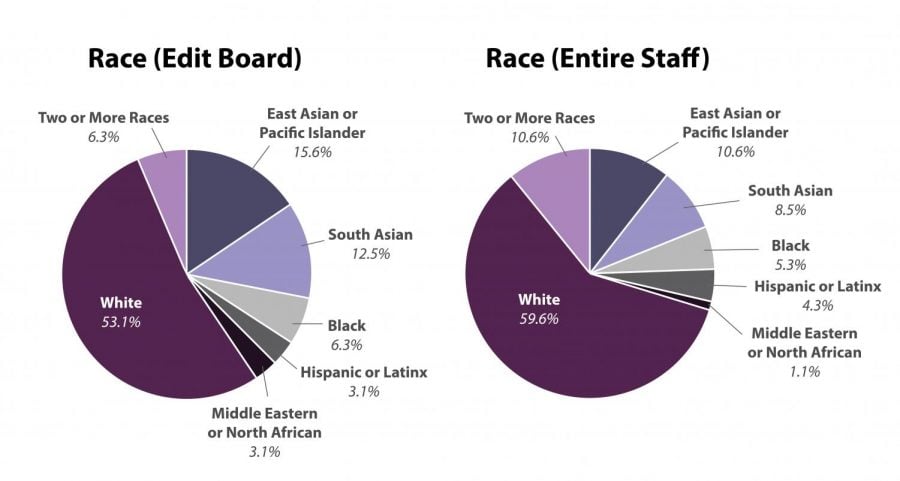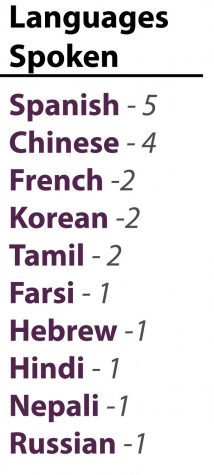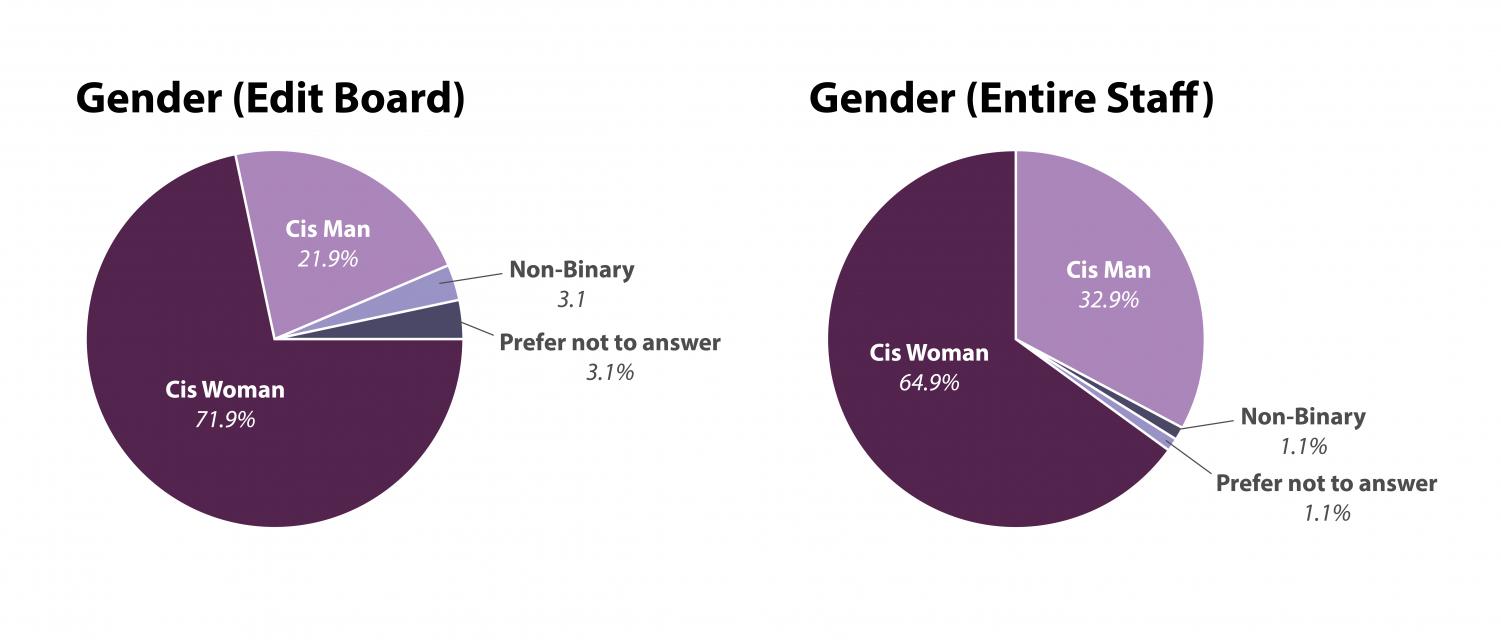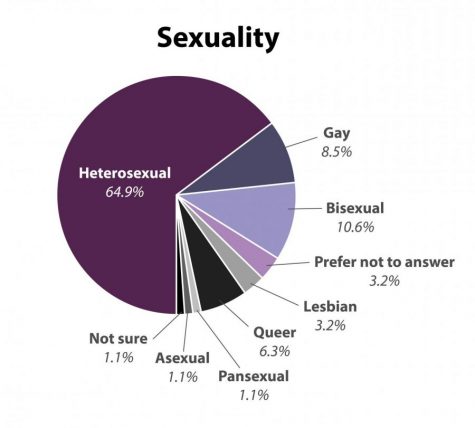The Daily Northwestern’s 2020 Diversity Report
June 5, 2020
For the past three years, The Daily Northwestern has done an internal survey of staffers that asks a series of questions concerning social identities like race, socioeconomic status, religion, hometown and more. This data is then used to form our annual diversity report.
We are not absolved from any criticism, no matter how well-intentioned our efforts to improve are, and we welcome feedback from the community to discuss anything from a single article we have published to the broader trends of reporting or staff diversity.
Below is our staff diversity report — while we have increased our representation on staff in some ways, we also have moved back or stayed stagnant in others. Next week, we will evaluate our reporting specifically from a lens of diversity and inclusion. As stated before, these reports are only a small fraction of the changes we’ve made to critically examine our newsroom and our coverage.
Editor’s note: Last year’s survey had a sample size of 68, while this one has a sample size of 94, which is due to increased staff participation. Comparisons to last year’s staff should be examined with this in mind. This year, we had a 100 percent response rate from our current edit board — we do not know how many total staffers work for us on a quarterly basis but this response rate is higher than usual.
Survey results
Unfortunately, though the paper gained more staffers of minoritized racial and ethnic groups, The Daily remains overwhelmingly white — about 60 percent of staffers identify as white only. The 31 East Asian, Pacific Islander and South Asian staffers are the next largest group, together representing 33 percent of staff. In comparison, black and Latinx people make up 5.3 percent and 4.3 percent of total staff respectively. However, an additional 10.6 percent of staff identify as two races or more.

On our Spring editorial board specifically, there is slightly more racial diversity than the rest of the staff, although it is also predominantly white and Asian.

According to the 2018 Diversity Report, Northwestern is 58 percent white and 23.5 percent Asian American/Pacific Islander. The Daily’s demographics mostly line up with those areas and is behind in terms of black and Latinx staffers. Our newsroom’s lack of racial diversity is often reflected in everything from our sourcing to the narratives we focus on in our articles. It is no secret that The Daily is seen as a white institution. In some ways, the presence of more minoritized staffers has helped us continue to build relationships within different communities — however, the racial proportions have not radically shifted since we first started collecting this data in 2018.
Though members of our Spring edit board hold a variety of racial minority identities — including a black and Latina editor in chief — the image of The Daily is still an overwhelmingly white one. While we have had an unprecedented three consecutive black and/or Latinx EICs who have pushed for more inclusive coverage, representation is not everything, and their identities do not completely absolve our publication from any mistakes made. The racial makeup of the Spring editorial board represents a larger problem within historically white media, where it is increasingly difficult for people of color to ascend to leadership positions within newsrooms.
The Daily is predominantly female, a demographic that has remained consistent since we started tracking our staff diversity in 2018. Women make up 64.9 percent of both the larger staff and the Spring editorial board. Regardless, many women on the editorial board have said they have struggled to gain respect from male staffers over the past few years. Non-cisgender staff are significantly underrepresented and are unfortunately down from the previous year — from 4.4 percent to just 1.1 percent. We have held conversations about covering non-cis identities and policies regarding asking pronouns, but The Daily still needs to increase its own gender diversity.

The Daily has more queer students on staff this year. 30.9 percent of staff hold queer identities, which has increased from 20.9 percent in 2018. According to the Associated Student Government analytics survey, 25 percent of students identify as LGBTQ+. Along with having more queer staffers, we have increased our coverage of queer communities in Evanston and at Northwestern, partially because of more representation on staff and existing connections.

In terms of income, The Daily has grown to include more low-income staffers, which partially stems from the introduction of the McCormick grant program, which was awarded through Medill beginning in the Fall Quarter to remove some of the barriers to reporting for The Daily through a quarterly stipend. The number of first-generation students has lowered from last year, representing 7.4 percent of staff compared to 13.5 percent of the University as of 2018.
However, our coverage has grown to be more inclusive of FGLI topics after historically not having covered those communities well. We still have a long way to go, but we are excited to continue finding nuances within larger stories that relate to this diverse group of students. We also hope to increase our established relationships within FGLI communities in coming years.
Takeaways
Our predominantly white, cis, straight, abled staff can hurt our coverage. Across desks, Daily staffers were hesitant to cover communities they did not belong to. We recognize the hesitation often comes from fear of not doing those communities justice. In order to address this issue, we had a continuous dialogue throughout the year about reporting on communities outside your own and specifically looked at how staffers can build relationships within those communities.
Looking at our edit boards, diversity matters just as much — representation at the higher level is important because of the way our pitching, writing and editing process works. When there are more people who have diverse perspectives at the top, there are more opportunities to refine concepts and make sure the resulting pieces are ready to be published, holding them for a later date when necessary. They also set the standard for holding conversations about diversity and set examples for inclusive thinking for the rest of the staff.
The Daily is an institution with incredible privilege on campus. We understand, now more than ever, our role in enabling discrimination on campus and within the city. We recognize this position and have worked hard to challenge our institution’s norms and reform a lot of problems. Though Spring Quarter was entirely remote, The Daily has reevaluated much of our coverage and made tangible changes to our editing process that are hopefully noticed by members of our community.
We urge other campus media outlets to publish similar reports about their own staff composition so we can be more transparent about our privileges as student reporters and move forward to building more equitable and inclusive newsrooms.

